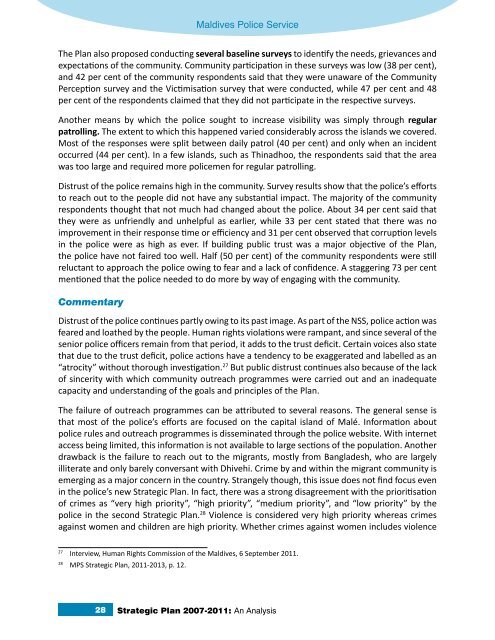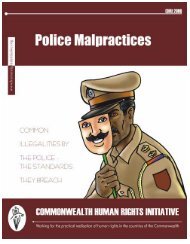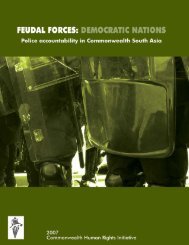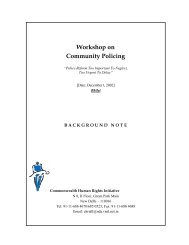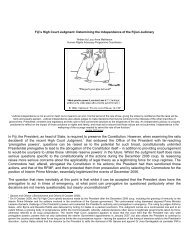Implementation of the Maldives Police Service Strategic Plan
Implementation of the Maldives Police Service Strategic Plan
Implementation of the Maldives Police Service Strategic Plan
Create successful ePaper yourself
Turn your PDF publications into a flip-book with our unique Google optimized e-Paper software.
<strong>Maldives</strong> <strong>Police</strong> <strong>Service</strong>The <strong>Plan</strong> also proposed conducting several baseline surveys to identify <strong>the</strong> needs, grievances andexpectations <strong>of</strong> <strong>the</strong> community. Community participation in <strong>the</strong>se surveys was low (38 per cent),and 42 per cent <strong>of</strong> <strong>the</strong> community respondents said that <strong>the</strong>y were unaware <strong>of</strong> <strong>the</strong> CommunityPerception survey and <strong>the</strong> Victimisation survey that were conducted, while 47 per cent and 48per cent <strong>of</strong> <strong>the</strong> respondents claimed that <strong>the</strong>y did not participate in <strong>the</strong> respective surveys.Ano<strong>the</strong>r means by which <strong>the</strong> police sought to increase visibility was simply through regularpatrolling. The extent to which this happened varied considerably across <strong>the</strong> islands we covered.Most <strong>of</strong> <strong>the</strong> responses were split between daily patrol (40 per cent) and only when an incidentoccurred (44 per cent). In a few islands, such as Thinadhoo, <strong>the</strong> respondents said that <strong>the</strong> areawas too large and required more policemen for regular patrolling.Distrust <strong>of</strong> <strong>the</strong> police remains high in <strong>the</strong> community. Survey results show that <strong>the</strong> police’s effortsto reach out to <strong>the</strong> people did not have any substantial impact. The majority <strong>of</strong> <strong>the</strong> communityrespondents thought that not much had changed about <strong>the</strong> police. About 34 per cent said that<strong>the</strong>y were as unfriendly and unhelpful as earlier, while 33 per cent stated that <strong>the</strong>re was noimprovement in <strong>the</strong>ir response time or efficiency and 31 per cent observed that corruption levelsin <strong>the</strong> police were as high as ever. If building public trust was a major objective <strong>of</strong> <strong>the</strong> <strong>Plan</strong>,<strong>the</strong> police have not faired too well. Half (50 per cent) <strong>of</strong> <strong>the</strong> community respondents were stillreluctant to approach <strong>the</strong> police owing to fear and a lack <strong>of</strong> confidence. A staggering 73 per centmentioned that <strong>the</strong> police needed to do more by way <strong>of</strong> engaging with <strong>the</strong> community.CommentaryDistrust <strong>of</strong> <strong>the</strong> police continues partly owing to its past image. As part <strong>of</strong> <strong>the</strong> NSS, police action wasfeared and loa<strong>the</strong>d by <strong>the</strong> people. Human rights violations were rampant, and since several <strong>of</strong> <strong>the</strong>senior police <strong>of</strong>ficers remain from that period, it adds to <strong>the</strong> trust deficit. Certain voices also statethat due to <strong>the</strong> trust deficit, police actions have a tendency to be exaggerated and labelled as an“atrocity” without thorough investigation. 27 But public distrust continues also because <strong>of</strong> <strong>the</strong> lack<strong>of</strong> sincerity with which community outreach programmes were carried out and an inadequatecapacity and understanding <strong>of</strong> <strong>the</strong> goals and principles <strong>of</strong> <strong>the</strong> <strong>Plan</strong>.The failure <strong>of</strong> outreach programmes can be attributed to several reasons. The general sense isthat most <strong>of</strong> <strong>the</strong> police’s efforts are focused on <strong>the</strong> capital island <strong>of</strong> Malé. Information aboutpolice rules and outreach programmes is disseminated through <strong>the</strong> police website. With internetaccess being limited, this information is not available to large sections <strong>of</strong> <strong>the</strong> population. Ano<strong>the</strong>rdrawback is <strong>the</strong> failure to reach out to <strong>the</strong> migrants, mostly from Bangladesh, who are largelyilliterate and only barely conversant with Dhivehi. Crime by and within <strong>the</strong> migrant community isemerging as a major concern in <strong>the</strong> country. Strangely though, this issue does not find focus evenin <strong>the</strong> police’s new <strong>Strategic</strong> <strong>Plan</strong>. In fact, <strong>the</strong>re was a strong disagreement with <strong>the</strong> prioritisation<strong>of</strong> crimes as “very high priority”, “high priority”, “medium priority”, and “low priority” by <strong>the</strong>police in <strong>the</strong> second <strong>Strategic</strong> <strong>Plan</strong>. 28 Violence is considered very high priority whereas crimesagainst women and children are high priority. Whe<strong>the</strong>r crimes against women includes violence27Interview, Human Rights Commission <strong>of</strong> <strong>the</strong> <strong>Maldives</strong>, 6 September 2011.28MPS <strong>Strategic</strong> <strong>Plan</strong>, 2011-2013, p. 12.28<strong>Strategic</strong> <strong>Plan</strong> 2007-2011: An Analysis


